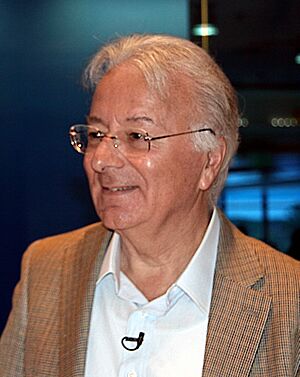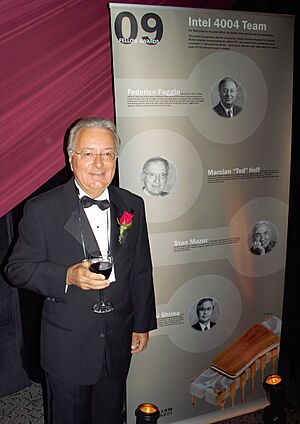Federico Faggin facts for kids
Quick facts for kids
Federico Faggin
|
|
|---|---|

Faggin in September 2011
|
|
| Born | 1 December 1941 |
| Citizenship | Italian, American |
| Alma mater |
|
| Known for |
|
| Children | one daughter (b. 1970) and two sons (b. 1979 and 1980) |
| Awards |
|
| Scientific career | |
| Fields | physics, electrical engineering |
| Institutions |
|
| Thesis | flying-spot scanners |
Federico Faggin (born 1 December 1941) is an Italian-American physicist, engineer, inventor, and business leader. He is famous for designing the Intel 4004, which was the first commercial microprocessor. A microprocessor is like the "brain" of a computer or electronic device.
Faggin also created a very important technology called the self-aligned MOS silicon-gate technology (SGT) in 1968. He did this while working at Fairchild Semiconductor. This invention made it possible to create many modern electronic parts. These include semiconductor memory chips, CCD image sensors, and microprocessors.
After the Intel 4004, he led the creation of other important microprocessors like the Intel 8008 and Intel 8080. He later co-founded Zilog, a company focused only on microprocessors. There, he led the development of the Zilog Z80 and Zilog Z8 processors. He also helped start other companies like Cygnet Technologies and Synaptics.
In 2010, he received the National Medal of Technology and Innovation. This is the highest award the United States gives for achievements in technology. In 2011, Faggin started the Federico and Elvia Faggin Foundation. This foundation supports scientific studies about consciousness.
Contents
Early Life and Learning
Federico Faggin was born in Vicenza, Italy. He grew up in a family that loved learning. His father, Giuseppe Faggin, was a scholar who wrote many books. He also translated old Greek texts into Italian.
Federico was very interested in technology from a young age. He went to a technical high school in Vicenza. Later, he earned a degree in physics from the University of Padua. He graduated with the highest honors.
Working at Olivetti
When he was 19, Faggin joined Olivetti. This company made typewriters and calculators. He helped design and build a small digital computer there in 1960. This computer used transistors and had a magnetic memory.
Olivetti later created one of the world's first programmable desktop calculators. It was called the Olivetti Programma 101. After this, Faggin studied physics and taught electronics at the University of Padua.
Joining SGS-Fairchild
In 1967, Faggin joined SGS-Fairchild. This was a company in Italy that worked with an American firm, Fairchild Semiconductor. There, he helped develop a new way to make electronic parts. He also designed the first two commercial MOS integrated circuits.
His work impressed the company, and he moved to Fairchild's offices in California in 1968. He stayed with Fairchild when the joint company ended.
Innovations in Silicon Valley
Fairchild Semiconductor and Silicon-Gate Technology
In California, Faggin led the creation of silicon-gate technology (SGT). He designed its special process. SGT was a huge step forward in microelectronics. It used a MOSFET with a silicon self-aligned gate.
SGT became the basis for all modern NMOS and CMOS integrated circuits. It made possible many key inventions. These include MOS semiconductor memory chips, the first microprocessor, and the first CCD and EPROM chips. SGT quickly replaced older technologies. Within ten years, it made older transistor-based circuits outdated.
The Fairchild 3708 Chip
At Fairchild, Faggin designed the first commercial integrated circuit using SGT. It was called the Fairchild 3708. This chip was an 8-bit analog multiplexer. It was much faster and more reliable than older chips. This showed how much better SGT was.
Working at Intel
Federico Faggin joined Intel in 1970. He became the project leader and designer for the MCS-4 family of microprocessors. This family included the Intel 4004, which was the world's first single-chip microprocessor. Faggin wanted to use his new SGT to design advanced chips, which Fairchild was not doing.
The 4004 (released in 1971) was possible because of SGT. Faggin also created a new way to design chips called random logic chip design. This method, along with his other design ideas, allowed him to fit the microprocessor onto one small chip.
He also added "buried contacts" to double the circuit density. He used "bootstrap loads" to make the chip five times faster. These ideas helped make the 4004 a single-chip microprocessor, which many thought would take many more years to achieve.
Faggin's design method was used for all of Intel's early microprocessors. It was also used later for Zilog's Z80.
The Intel 4004 was a 4-bit CPU (central processing unit) on one chip. It was part of a family of four chips made for Busicom, a Japanese calculator company. Faggin pushed for Intel to sell the MCS-4 to other customers. He built a tester for the 4004 using the 4004 itself. This convinced Intel's management to sell the chip more widely.
In 2009, the four main people who helped create the 4004 were honored. These included Ted Hoff, Stan Mazor, Masatoshi Shima, and Federico Faggin. Faggin led the design and made key inventions to make the 4004 possible on a single chip.
The Intel 2102A was a faster version of an existing memory chip. Faggin helped design it in 1973. This chip was five times faster and opened new possibilities for Intel.
Developing Early Intel Microprocessors
Faggin's chip design methods were used for all of Intel's first microprocessors.
The Intel 8008 was the world's first single-chip 8-bit CPU. It was also built using SGT. Faggin directed its development, and Hal Feeney did the chip design. The idea for the 8008 came from another company, CTC Inc.
The Intel 4040 microprocessor (1974) was an improved version of the 4004. Faggin created its design, and Tom Innes did the actual design work.
The 8080 microprocessor (1974) was the first high-performance 8-bit microprocessor. It used a faster type of SGT. Faggin thought of and designed the 8080. Masatoshi Shima designed the chip under Faggin's guidance. The 8080 was much better than the 8008. It was faster and easier to connect to other parts. Its low cost and high performance allowed microprocessors to be used in many new ways. This included the first personal computers.
When Faggin left Intel in 1974, he was in charge of all MOS products, except for memory chips.
Starting Zilog
The Zilog Z80 was the first microprocessor made by Zilog. This was the first company created just for microprocessors. Federico Faggin and Ralph Ungermann started Zilog in November 1974. Faggin was the president and CEO. He designed the Z80 CPU and its related parts.
The Z80-CPU was a big improvement over the 8080. It was faster and had more features. It was part of a family of chips that helped build powerful and affordable microcomputers. The Z80 was used in many early personal computers. It was also in video game systems like the MSX and Master System. The Z80 was produced until 2024.
The Zilog Z8 micro controller (1978) was one of the first single-chip microcontrollers. It had an 8-bit CPU, memory, and input/output features all on one chip. This made it useful for many control systems. The Z8 was also produced until 2024.
The Communication CoSystem
Faggin also thought of the Communication CoSystem (1984). His second company, Cygnet Technologies, Inc., designed and built it. This system connected to a personal computer and a phone line. It could handle phone calls, emails, and other communications automatically.
Leading Synaptics
In 1986, Faggin co-founded Synaptics and was its CEO until 1999. Synaptics first worked on artificial neural networks. These are computer systems that learn like brains.
In 1994, Synaptics introduced the touchpad. This replaced the trackball on laptop computers and was widely adopted. Synaptics also created early touchscreens. These are now used in almost all smartphones and tablets. Faggin helped develop the idea for these products. He is a co-inventor on ten patents for Synaptics.
Working at Foveon
From 2003 to 2008, Faggin was president and CEO of Foveon. He helped the company create image sensors that were better than others. These sensors were also smaller. He oversaw Foveon's sale to the Japanese Sigma Corporation in 2008.
Federico and Elvia Faggin Foundation
In 2011, Faggin founded the "Federico and Elvia Faggin Foundation." This foundation supports scientific research into consciousness at universities in the United States. Its goal is to better understand consciousness through science. Faggin's interest in this topic started when he worked on artificial neural networks at Synaptics. He wondered if it was possible to build a conscious computer.
Ideas on Consciousness
In his 2024 book Irreducible - Consciousness, life, computers, and human nature, Federico Faggin shared his ideas about consciousness. He suggests that consciousness is a quantum phenomenon. This means it's linked to the tiny particles and energy that make up everything. He believes each person's consciousness is unique.
His ideas are supported by two quantum physics rules. One rule says that a pure quantum state cannot be perfectly copied. The other rule limits how much information can be measured from a quantum state. Faggin suggests that conscious experiences are like these pure quantum states. They are private and can only be known from inside the system that has them. He believes that a regular computer can never be conscious because computer information can be copied perfectly.
Faggin's theory suggests that consciousness is not tied to the body's functions. It could continue to exist even after the body dies. He sees the body as being controlled by consciousness, like a drone. This new theory is based on studies by Professor Giacomo Mauro D'Ariano and Faggin's own experiences and research.
Awards and Honors
- 1988: Marconi International Fellowship Award for his work on the microprocessor.
- 1988: Gold Medal for Science and Technology from the Italian Prime Minister.
- 1988: Title of "Grande Ufficiale" from the President of Italy.
- 1994: W. Wallace McDowell Award for developing Silicon Gate Process and the first commercial microprocessor.
- 1994: Honorary degree in Computer Science from the University of Milan.
- 1996: Ronald H. Brown American Innovator Award.
- 1996: Lifetime Achievement Award by P.C. Magazine.
- 1996: Inducted into National Inventors Hall of Fame.
- 1997: Kyoto Prize.
- 1997: George R. Stibitz Computer Pioneer Award.
- 1997: Masi Civilta' Veneta Prize.
- 2001: Dr. Robert Noyce Memorial Award.
- 2002: Honorary degree in Electronic Engineering from the University of Rome Tor Vergata.
- 2003: AeA/Stanford Executive Institute Award.
- 2006: European Inventor of the Year Lifetime Achievement Award.
- 2007: Honorary degree in Electronic Engineering from the University of Pavia.
- 2008: Honorary degree in Electronic Engineering from the University of Palermo.
- 2009: Honorary degree in Computer Sciences from the University of Verona.
- 2009: Fellow of the Computer History Museum for his work on the Intel 4004.
- 2009: National Medal of Technology and Innovation from U.S. President Barack Obama.
- 2011: The George R. Stibitz Lifetime Achievement Award for his foundational contributions to modern technology.
- 2019: Knight Grand Cross of the Order of Merit of the Italian Republic from the President of Italy.
- 2012: Global Information Technology Award from the President of Armenia.
- 2012: Honorary PhD from the Polytechnic University (Armenia).
- 2012: Premio Franca Florio.
- 2013: Honorary PhD in science from Chapman University (CA).
- 2014: Enrico Fermi Award for inventing the MOS silicon gate technology and the first modern microprocessor.
- 2018: IEEE Italy Section Honorary Award for his contributions to silicon gate technology and the first microprocessor.
- 2018: AAAS Fellow by the American Association for the Advancement of Science.
- 2019: Honorary PhD in computer engineering from the University of Pisa (Italy).
- 2023: Sigillum Magnum from the University of Bologna.


